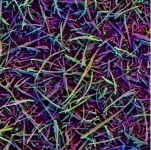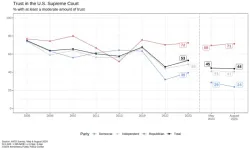(Press-News.org) Inside every cell, inside every nucleus, your continued existence depends on an incredibly complicated dance. Proteins are constantly wrapping and unwrapping DNA, and even minor missteps can lead to cancer.
A new study from the University of Chicago reveals a previously unknown part of this dance—one with significant implications for human health.
In the study, published Oct. 2 in Nature, a team of scientists led by UChicago Prof. Chuan He, in collaboration with University of Texas Health Science Center at San Antonio Prof. Mingjiang Xu, found that RNA plays a significant role in how DNA is packaged and stored in your cells, via a gene known as TET2. This pathway also appears to explain a long-standing puzzle about why so many cancers and other disorders involve TET2-related mutations—and suggests a set of new targets for treatments.
“This represents a conceptual breakthrough,” said He, who is the John T. Wilson Distinguished Service Professor in the Department of Chemistry and the Department of Biochemistry and Molecular Biology and an investigator of the Howard Hughes Medical Institute.
“Not only does it offer targets for therapy for several diseases, but we are adding to the grand picture of chromatin regulation in biology,” he said. “We hope the real-world impact is going to be very high.”
RNA revelations
He’s lab has made several discoveries that shook up our picture of how genes are expressed. In 2011, they found that, in addition to modifications to DNA and proteins, modifications to RNA may also control what genes are expressed.
Since then, He and his team have found more and more ways that RNA methylation is fundamentally involved in which genes are turned on and off in both the plant and animal kingdoms.
With this lens, they turned their attention to a gene called TET2. For a long time, we’ve known that when TET2 or TET2-related genes are mutated, all sorts of problems follow. These mutations occur in 10-60% of different human leukemia cases, and pop up in other types of cancers as well. The problem was that we didn’t know why—which significantly hampers the search for treatments.
The other members of the TET family act on DNA, so for years, researchers had been looking at TET2’s effects on DNA. But He’s lab found they’d been looking in the wrong place: TET2 actually affects RNA.
When your cells print their own copies of your genetic material, they have to be neatly packaged up and folded for later reference; the packages are known as chromatin. If that doesn’t happen correctly, all sorts of issues can follow. It turns out that RNA is a key player in this process, and that its role is controlled by TET2 through a modification process called methylation.
Through a clever set of experiments, removing genes and seeing what happened, the He lab team showed how this works. They found that TET2 controls how often a type of modification known as m5C occurs on certain types of RNA, which attracts a protein known as MBD6, which in turn controls the packaging of chromatin.
When you’re an infant and your cells are actively dividing into different types of cells, TET2 loosens up the reins so that chromatin can be more easily accessed and stem cells can turn into other cells. But once you’re an adult, TET2 is supposed to tighten up the reins. If that repressing force gets lost, MBD6 has free rein, and havoc can ensue.
“If you have a TET2 mutation, you reopen this growth pathway that could eventually lead to cancer—especially in the blood and brain, because this pathway looks to be most important in blood and brain development,” said He.
As a final confirmation, the team tested human leukemia cells in petri dishes. When the team removed the cells’ ability to create MBD6, effectively pulling on the reins, the leukemia cells all died.
‘A silver bullet’
The most exciting part of this discovery to cancer researchers is that it gives them a whole new set of targets for drugs.
“What we hope we can get from this is a silver bullet to selectively get rid of just cancer cells, by targeting this specific pathway activated because of TET2 or IDH loss,” said He, who is working with UChicago’s Polsky Center for Entrepreneurship and Innovation to found a startup company to create just such a drug.
But we also know that TET2 mutations have consequences other than cancer. TET2 mutations also occur in a fraction of all adults older than 70 and contribute to an increased risk of heart disease, stroke, diabetes, and other inflammatory conditions, a condition known as CHIP.
“These patients have TET2 mutant blood cells, but they haven’t yet caused cancer,” explained Caner Saygin, an oncologist and assistant professor of medicine at the University of Chicago Medicine who specializes in treating CHIP patients and is also working with the He lab on several projects. “But these TET2 mutant cells are more inflammatory, and as they circulate, they cause an increased risk for things like heart, liver, and kidney diseases. Right now, I cannot prescribe anything to these patients because they don’t have cancer yet, but if we could eliminate those mutant cells, we could improve their lives.”
A radical change
The finding is also a radical change in our understanding of chromatin—and hence gene expression as a whole.
Previously, we knew that one form of RNA methylation called m6A affects gene expression—its placement and removal affects the packaging of chromatin, which directs which stretches of DNA are translated into reality.
But if m5C is also in this category, that suggests this is a general mechanism to control chromatin and gene expression, and there could be more. “If there’s a second, you could have a third, fourth, fifth,” said He. “This says that RNA modification on chromatin is a major mechanism for chromatin and gene transcription regulation. We think this pathway is just the tip of the iceberg.”
Citation: “RNA m5C oxidation by TET2 regulates chromatin state and leukaemogenesis.” Zou, Dou, and Li et al, Nature, Oct. 2, 2024.
Funding: National Institute of Health.
END
UChicago scientists decode key mutation in many cancers
Finding points to expanded role of RNA in human gene expression
2024-10-02
ELSE PRESS RELEASES FROM THIS DATE:
NYU Langone awarded $1.6 million to investigate Alzheimer’s & Parkinson’s progression through the eye
2024-10-02
Researchers at NYU Langone Health were awarded $1.6 million from the National Institutes of Health (NIH) to investigate changes in the eye that may indicate early signs of Alzheimer’s disease and Parkinson’s disease.
The award, OT2OD038130, recognizes the eye as a part of the brain and its role as a window into cognitive and visual health. After the initial $1.6 million award, the grant may renew an additional two years, for a total of $4.8 million as part of the NIH Common Fund Venture Program’s new Oculomics Initiative. Oculomics is a relatively new term to describe the integrative use of technology and ...
Missing link found in gamma emission phenomena from thunderclouds
2024-10-02
Groundbreaking Discoveries in Gamma-Ray Emissions from Thunderstorms
In the recent edition of Nature, groundbreaking results about the gamma-ray emissions produced during thunderstorms are presented. Overall, these findings reveal that gamma-ray emission from thunderclouds is much more complex, diverse, and dynamic than previously thought. Understanding these phenomena is crucial to uncovering the secrets of lightning.
Flickering Gamma-Ray Flashes: A New Discovery
Entitled “Flickering Gamma-Ray Flashes, the Missing Link between Gamma Glows and TGFs,” the paper by Østgaard et al. [2024] reports unique observations of a new phenomenon called Flickering Gamma-Ray ...
Social media users’ actions, rather than biased policies, could drive differences in platform enforcement
2024-10-02
A new paper, “Differences in misinformation sharing can lead to politically asymmetric sanctions,” published today in Nature suggests that the higher quantity of social media policy enforcement (such as account suspensions) for conservative users could be explained by the higher quantity of misinformation shared by those conservative users — and so does not constitute evidence of inherent biases in the policies from social media companies or in the definition of what constitutes misinformation.
Written by ...
How a bacterium becomes a permanent resident in a fungus
2024-10-02
Endosymbiosis is a fascinating biological phenomenon in which an organism lives inside another. Such an unusual relationship is often beneficial for both parties. Even in our bodies, we find remnants of such cohabitation: mitochondria, the powerhouses of our cells, evolved from an ancient endosymbiosis. Long ago, bacteria entered other cells and stayed. This coexistence laid the foundation for mitochondria and thus the cells of plants, animals, and fungi.
What is still poorly understood, however, is how an endosymbiosis as a lifestyle actually arises. A bacterium that more or less accidentally ...
Study: For long COVID, lithium aspartate at low doses is ineffective, but higher doses may be promising
2024-10-02
BUFFALO, N.Y. — A small University at Buffalo clinical trial has found that at low doses, lithium aspartate is ineffective in treating the fatigue and brain fog that is often a persistent feature of long COVID; however, a supplemental dose-finding study found some evidence that higher doses may be effective.
Published in JAMA Network Open on Oct. 2, the study was led by Thomas J. Guttuso, Jr., MD, professor of neurology in the Jacobs School of Medicine and Biomedical Sciences at UB and a physician with UBMD Neurology.
“It’s a negative study with a positive twist,” Guttuso concludes.
Because ...
Online insomnia treatment can help caregivers get much-needed rest, study suggests
2024-10-02
Providing care for a family member with a disabling illness can be a demanding job that leaves many people unable to sleep, but an online insomnia treatment developed at the University of Virginia School of Medicine can help, new research shows.
Not only did the SHUTi (Sleep Healthy Using the Internet) sleep intervention help caregivers get better rest, it most benefited those shouldering the greatest responsibilities in caring for their loved ones, the researchers found.
The results suggest the online format of the program ...
Attivare licenses Wyss Institute’s immune-modulating biomaterial technology to advance immunotherapies
2024-10-02
Attivare licenses Wyss Institute’s immune-modulating biomaterial technology to advance immunotherapies
The company is developing the biomaterial-based technology to develop novel therapies able to program anti-cancer immunity and prevent infectious diseases
By Benjamin Boettner
(BOSTON) — Today, the Wyss Institute for Biologically Inspired Engineering at Harvard University and Attivare Therapeutics Inc. announced that Attivare has licensed a portfolio of immune-modulating biomaterial technologies from Harvard University that was created at the ...
Regenstrief, Fairbanks researcher among 25 fellows to be inducted into American College of Medical Informatics
2024-10-02
The American College of Medical Informatics (ACMI) has announced that Chris Harle, PhD, of the Indiana University Richard M. Fairbanks School of Public Health and the Regenstrief Institute will be inducted as one of 25 new fellows on November 10 in San Francisco, CA, at ceremonies during the American Medical Informatics Association (AMIA) 2024 Annual Symposium.
ACMI is a college of elected fellows who have made significant and sustained contributions to the field of biomedical informatics. Individuals who have achieved national recognition in the field and are committed to advancing ...
Ontario Institute for Cancer Research funding aims to speed the development of new drugs for some of the most common cancers
2024-10-02
October 2, 2024, TORONTO – The Ontario Institute for Cancer Research (OICR) continues to support Ontario drug discovery research by funding high-quality investigations of new therapies for some of the most prevalent pediatric and adult cancers. These projects are tackling substantial challenges in cancer by increasing the effectiveness and availability of immunotherapies, making cancer more vulnerable to chemotherapy and developing a new drug for one of the deadliest forms of childhood brain cancer.
OICR’s Cancer Therapeutics Innovation Pipeline (CTIP) initiative is supporting three research teams ...
Trust in US Supreme Court continues to sink
2024-10-02
PHILADELPHIA – Driven by political partisanship, public trust in the U.S. Supreme Court has continued a downward slide since the court’s 2022 Dobbs decision overturning the Roe v. Wade ruling that established a constitutional right to abortion, according to a new survey by the Annenberg Public Policy Center (APPC) of the University of Pennsylvania.
More than half of Americans (56%) now disapprove of the Supreme Court, saying they trust it either “a little” or “not at all” to act in the best interest ...
LAST 30 PRESS RELEASES:
Why nail-biting, procrastination and other self-sabotaging behaviors are rooted in survival instincts
Regional variations in mechanical properties of porcine leptomeninges
Artificial empathy in therapy and healthcare: advancements in interpersonal interaction technologies
Why some brains switch gears more efficiently than others
UVA’s Jundong Li wins ICDM’S 2025 Tao Li Award for data mining, machine learning
UVA’s low-power, high-performance computer power player Mircea Stan earns National Academy of Inventors fellowship
Not playing by the rules: USU researcher explores filamentous algae dynamics in rivers
Do our body clocks influence our risk of dementia?
Anthropologists offer new evidence of bipedalism in long-debated fossil discovery
Safer receipt paper from wood
Dosage-sensitive genes suggest no whole-genome duplications in ancestral angiosperm
First ancient human herpesvirus genomes document their deep history with humans
Why Some Bacteria Survive Antibiotics and How to Stop Them - New study reveals that bacteria can survive antibiotic treatment through two fundamentally different “shutdown modes”
UCLA study links scar healing to dangerous placenta condition
CHANGE-seq-BE finds off-target changes in the genome from base editors
The Journal of Nuclear Medicine Ahead-of-Print Tip Sheet: January 2, 2026
Delayed or absent first dose of measles, mumps, and rubella vaccination
Trends in US preterm birth rates by household income and race and ethnicity
Study identifies potential biomarker linked to progression and brain inflammation in multiple sclerosis
Many mothers in Norway do not show up for postnatal check-ups
Researchers want to find out why quick clay is so unstable
Superradiant spins show teamwork at the quantum scale
Cleveland Clinic Research links tumor bacteria to immunotherapy resistance in head and neck cancer
First Editorial of 2026: Resisting AI slop
Joint ground- and space-based observations reveal Saturn-mass rogue planet
Inheritable genetic variant offers protection against blood cancer risk and progression
Pigs settled Pacific islands alongside early human voyagers
A Coral reef’s daily pulse reshapes microbes in surrounding waters
EAST Tokamak experiments exceed plasma density limit, offering new approach to fusion ignition
Groundbreaking discovery reveals Africa’s oldest cremation pyre and complex ritual practices
[Press-News.org] UChicago scientists decode key mutation in many cancersFinding points to expanded role of RNA in human gene expression




